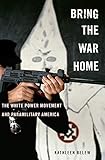Bring the war home : the white power movement and paramilitary America / Kathleen Belew.
Material type: TextPublication details: Cambridge, Massachusetts : Harvard University Press, (c)2018.Description: 1 online resource (x, 339 pages) : illustrationsContent type:
TextPublication details: Cambridge, Massachusetts : Harvard University Press, (c)2018.Description: 1 online resource (x, 339 pages) : illustrationsContent type: - text
- computer
- online resource
- 9780674984943
- White power movement and paramilitary America
- HS2325 .B756 2018
- COPYRIGHT NOT covered - Click this link to request copyright permission: https://lib.ciu.edu/copyright-request-form
| Item type | Current library | Collection | Call number | URL | Status | Date due | Barcode | |
|---|---|---|---|---|---|---|---|---|
 Online Book (LOGIN USING YOUR MY CIU LOGIN AND PASSWORD)
Online Book (LOGIN USING YOUR MY CIU LOGIN AND PASSWORD)
|
G. Allen Fleece Library ONLINE | Non-fiction | HS2325 (Browse shelf(Opens below)) | Link to resource | Available | on1028731825 |
Includes bibliographies and index.
The white power movement in America wants a revolution. It has declared all-out war against the federal government and its agents, and has carried out; with military precision; an escalating campaign of terror against the American public. Its soldiers are not lone wolves but are highly organized cadres motivated by a coherent and deeply troubling worldview of white supremacy, anticommunism, and apocalypse. In Bring the War Home, Kathleen Belew gives us the first full history of the movement that consolidated in the 1970s and 1980s around a potent sense of betrayal in the Vietnam War and made tragic headlines in the 1995 bombing of Oklahoma City. Returning to an America ripped apart by a war which, in their view, they were not allowed to win, a small but driven group of veterans, active-duty personnel, and civilian supporters concluded that waging war on their own country was justified. They unified people from a variety of militant groups, including Klansmen, neo-Nazis, skinheads, radical tax protestors, and white separatists. The white power movement operated with discipline and clarity, undertaking assassinations, mercenary soldiering, armed robbery, counterfeiting, and weapons trafficking. Its command structure gave women a prominent place in brokering intergroup alliances and bearing future recruits. Belew's disturbing history reveals how war cannot be contained in time and space. In its wake, grievances intensify and violence becomes a logical course of action for some. Bring the War Home argues for awareness of the heightened potential for paramilitarism in a present defined by ongoing war. --
Introduction -- Part I. Formation. The Vietnam War story ; Building the underground ; A unified movement ; Mercenaries and paramilitary praxis -- Part II. The war comes home. The revolutionary turn ; Weapons of war ; Race war and white women -- Part III. Apocalypse. Ruby Ridge, Waco, and militarized policing ; The bombing of Oklahoma City -- Epilogue.
COPYRIGHT NOT covered - Click this link to request copyright permission:
There are no comments on this title.
